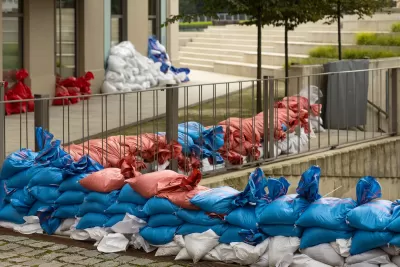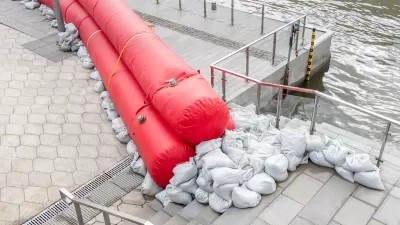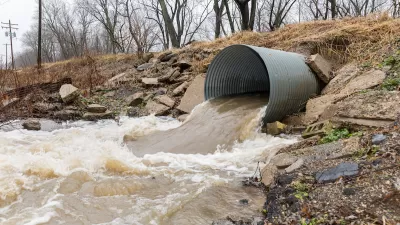Flooding causes over $400 billion in damage in the United States every year.

Flooding is becoming increasingly deadly and costly for American communities. In recent years, the cost of flooding has reached almost $496 billion annually.
In an article in Governing, Carl Smith explains how the crisis is reaching more places — even some thought to be ‘climate havens’ — and how cities are taking action to protect their residents and infrastructure.
To both prepare for potential flooding and conserve water to ensure a steady supply during droughts, cities are building ‘green’ stormwater infrastructure that returns water to the soil and channels it to retention ponds rather than letting it drain to lakes or oceans.
Because watersheds cross multiple jurisdictions, policymakers and planners need to collaborate across cities, counties, and states. “Stormwater needs to be considered as part of the larger water picture. Runoff from city streets or farmland can pollute drinking water. Floods can overwhelm wastewater systems. Ideally, these systems can be integrated in ways that create savings rather than damage. Stormwater retention can recharge aquifers and all sorts of recycled water can be used for drinking.”
FULL STORY: Flooding Is a $400 Billion Problem That's Getting Worse

Alabama: Trump Terminates Settlements for Black Communities Harmed By Raw Sewage
Trump deemed the landmark civil rights agreement “illegal DEI and environmental justice policy.”

Planetizen Federal Action Tracker
A weekly monitor of how Trump’s orders and actions are impacting planners and planning in America.

Why Should We Subsidize Public Transportation?
Many public transit agencies face financial stress due to rising costs, declining fare revenue, and declining subsidies. Transit advocates must provide a strong business case for increasing public transit funding.

Understanding Road Diets
An explainer from Momentum highlights the advantages of reducing vehicle lanes in favor of more bike, transit, and pedestrian infrastructure.

New California Law Regulates Warehouse Pollution
A new law tightens building and emissions regulations for large distribution warehouses to mitigate air pollution and traffic in surrounding communities.

Phoenix Announces Opening Date for Light Rail Extension
The South Central extension will connect South Phoenix to downtown and other major hubs starting on June 7.
Urban Design for Planners 1: Software Tools
This six-course series explores essential urban design concepts using open source software and equips planners with the tools they need to participate fully in the urban design process.
Planning for Universal Design
Learn the tools for implementing Universal Design in planning regulations.
Caltrans
Smith Gee Studio
Institute for Housing and Urban Development Studies (IHS)
City of Grandview
Harvard GSD Executive Education
Toledo-Lucas County Plan Commissions
Salt Lake City
NYU Wagner Graduate School of Public Service





























